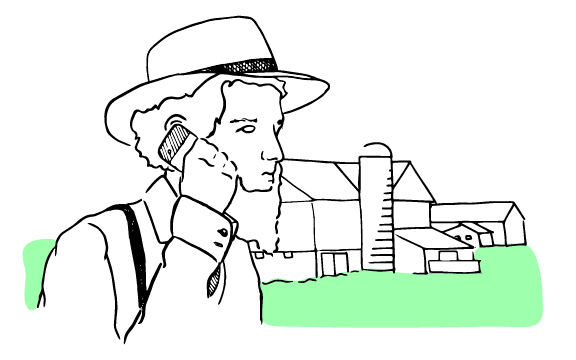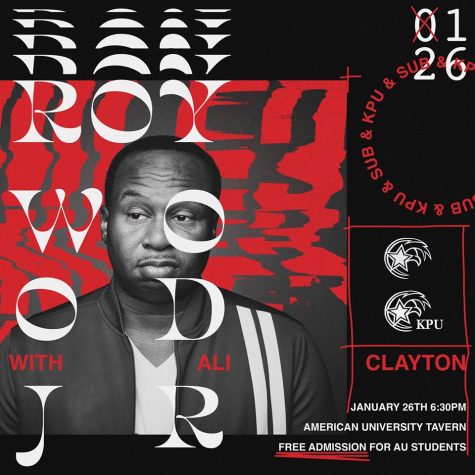Breaking Amish and Back Again: A Rumspringa Tale

The landscape is all gently rolling, snow-covered hills dotted with farms and cattle. It looks bleak after the latest winter storm, with a backdrop of skeleton trees and pale skies. The only spots of color come from laundry pinned up on long clotheslines, undulating gently on the cold breeze.
But when the train pulls into the Lancaster, Pennsylvania station a few minutes later, the scene outside is quite different. There are colorful row houses and trendy little cafés—one, owned by Mennonite couple Kathleen and Matt Smucker, comes highly recommended both by my cabdriver and the broke twentysomething panhandling outside the station. There are children strolling up and down the sidewalks—the older ones plugged into their iPods, the younger ones running ahead with their cartoon-themed backpacks jouncing up and down.
This city and the farms on its outskirts are the heart of Pennsylvania’s Amish country, but it wasn’t the quaint horse and buggies that lured me out of my residential Washington, DC neighborhood. It was the thought that while my university peers and I dragged our caffeinated, sleep-deprived bodies toward expected life goals—high GPAs, solid internships, successful careers—young people the same age as us were embracing a plainer, simpler life.
Or were they? Lucy Walker’s 2002 documentary _The Devil’s Playground_ painted a vivid picture of Amish adolescence—a particular period known as “rumspringa”—in Elkhart-LaGrange County, Indiana as a boozy, drug-laced haze of partying and adoption of “English,” or non-Amish, behaviors. One of the film’s protagonists, 18-year-old Faron Yoder, owned a car and was a regular user and dealer of methamphetamine. Young girls spoke casually of hard drinking, marijuana, and pre-marital sex—all while wearing long, homemade dresses and simple bonnets.
“For most kids, rumspringa means going out and getting wasted,” Yoder explained at one point. “And you have a hangover and then you go back and join church. It’s like a vaccination. You get a little dose of the outside world, so you know what it’s like and you won’t be tempted later on.”
For some, what Yoder says is true. Rumspringa, loosely translated as “running around,” is a period of a young Amish person’s life beginning around age 16 and lasting either until marriage or baptism into the Amish church. The idea is to test the material comforts of the modern
world—satellite television, cars and Xbox, to name a few—before committing to the Church and its rules.
But for others, there are wild inaccuracies between the true Amish way of life and what the media portrays today. Walker’s documentary is only one example—TLC’s _Breaking Amish_ and Discovery’s _Amish Mafia_ also reveal false “truths” about the reclusive community.
Even Lancaster natives like Jacob Wanner, a junior at American Uni- versity, are susceptible to the likes of _Amish Mafia_.
“We were so into it for a little while,” Wanner admitted. “At first we were like ‘maybe this is real!’” The blurred-out faces seemed to lend the show some authenticity, and he says it was exciting to see familiar landmarks.
“It was just entertaining, and then we realized that it was absolutely ridiculous,” Wanner said.
Kathleen Smucker, who has lived in Lancaster her entire life, adds that it can be upsetting to see a community from her city misrepresented by the media. “It’s just sickening to watch it,” she said. “And I know a lot of people aren’t believing it, but some people are, and it’s just so far off.”
“That’s what reality is here now,” added Terry Bryant, who teaches backpack journalism and television production, among other things, at AU. “It is hours and hours of video shot and edited down to what producers think are the most exciting things that people will watch. And I’ve listened to a couple podcasts about the production of reality shows, and the producers have even said, ‘We go home at night feeling dirty.’”
h3. AMISH FOUNDATIONS AND MISCONCEPTIONS
The faith itself, based on Anabaptist Christianity, revolves around the concept of the “Ordnung,” which, while not outlined in the Bible, has its roots in scripture. Essentially, the Ordnung is an unwritten set of rules thatestricts aspects of daily life—for example, limiting the style and color of clothing and prohibiting practices like divorce, running for political office, going on the public electricity grid and owning certain technology.
The rules vary from community to community—and, contrary to popular belief, there are many different communities of Amish.
“When you talk about Amish, it’s kind of like talking about Christians,” said Dr. Jim Cates, a psychotherapist and one of the founders of the Amish Youth Vision Project. “When you say somebody is a Christian, well, are they Catholic, are they Lutheran, are they Baptist?”
The Amish Youth Vision Project emerged as an attempt to lower risk behaviors associated with drugs and alcohol in the Elkhart-LaGrange area. Cates said its intervention programs, based on input directly from the Amish community, have been successful so far in raising awareness among Amish youth of dangerous behaviors, particularly alcohol.
The organization was also a direct response to Walker’s documentary. As Cates explained it, Walker went to Elkhart-LaGrange, the third largest Amish settlement in the world and began filming for her documentary. She didn’t mention that her piece was going to be about rumspringa—as far as members of the community were concerned, it was simply going to depict Amish life.
“At the point that she did this, there were not all these documenta-ries, all this information out on the Amish,” Cates said. “So they invited her literally into their homes. She did filming of all kinds of things […] She has, somewhere in film vaults, or on film somewhere, all kinds of documentary film of the Amish just being Amish and talking with her. And that’s the tragedy of what happened—that that has been lost now and they won’t talk to anyone like that for years to come.”
Still, while the film sparked anger and feelings of betrayal among community members for what they viewed as sensationalized accounts of rumspringa, others recognized shreds of truth.
“A number of the community leaders—and bishops are a lot of times the community leaders in an Amish community—a number of bishops felt like [the documentary] is highlighting a problem we need to address,” Cates said.
h3. AMONG THE AMISH
But, Cates said, it’s important to remember that, though they exist, cases like those portrayed in Walker’s film are anomalies.
Sam Mason, a sophomore studying International Relations at American University, can attest to that. He comes from a tiny community called Chrome in Chester County, Pennsylvania. Of its 30 to 40 residents, he estimated that about half are Amish or Mennonite. Growing up, he had limited interaction with his Amish neighbors—most of the time, any commingling that occurred was work-related.
“My interaction with the Amish was mostly based on proximity, because they were my neighbors, and utility because we are both farmers who live in the same area,” Mason said. “Obviously, we’re going to interact because we’re going to help each other out.” Still, even for neighbors, he says interaction with the Amish on any scale “is pretty limited.”
Even when his Amish neighbors began rumspringa, Mason said he still didn’t have much contact with them. He never heard of any wild Amish parties around, much less got an invitation to one.
“It’s kind of a fantasized, romanticized process that people think, ‘Oh these people that don’t use electricity suddenly go into this stage where they can do whatever they want’ and they just imagine, like, Amish orgies and meth parties,” he said. “My Amish neighbors, their rumspringa is to go buy a six pack of beer and go into the woods and get drunk.”
The scene Mason described is not unlike the escapades of many young adults today and is a more accurate picture of Amish youth than the one depicted in Walker’s documentary. But even low-key parties are more than some families are comfortable with. In some cases, rumspringa has even factored into families’ decisions to leave the church.
Shortly after they were married, Smucker’s parents made that very choice.
“Basically, my parents left because they wanted something better for their children,” Smucker said. Rather than let them dive hard and fast into the “English” world of “temptations” during rumspringa, they chose to leave and join a Mennonite church.
In 1966, there began a transitional period during which the church split into what is today known as “Old Order” and “New Order” Amish. The two groups are similar, though New Order Amish tend to be less strict about shunning and more strict when it comes to alcohol. Smucker’s parents were not shunned as a consequence of their departure because they left during this period. But “meidung,” or shunning, is still very much a part of Amish life. In fact, Smucker’s husband, Matt, comes from a similar background: when he was seven years old, his parents also left the church. But because they left after the split, their community, even their family, shunned them.
“Different ones in the family take it more seriously, and there’s others who are okay with it and don’t make a big deal of it,” explained Smucker. “In the beginning, when they left, it was of course more difficult.” Now, certain members of the family—his maternal grandparents, for instance—more or less ignore the ban, despite the disapproval of the church. Others choose to obey the ban, refusing to eat from the same table as Matt’s parents.
“Shunning you is for them their last way of showing that they love you,” Velda Bontrager explained in Walker’s documentary. “They feel that you are breaking a promise you made when you joined the Amish church.”
Bontrager initially joined after her rumspringa, but ultimately decid- ed to leave and was consequentially shunned. Even though she says in the film that she is excited about taking classes at a local community college and looking forward to all the opportunities before her, her face reveals the pain of being cast out of the community.
“They fear for your soul,” she said. “I lost the support of my family. Nobody would talk to me. It was like I wasn’t even there.”
h3. AMISH IN THE 21ST CENTURY
Two words that are not ordinarily associated: Amish and iPhone. The ability of the Amish to hold on to the core beliefs that set them apart is remarkable in its endurance: plain dress to discourage vanity and an absence of personal cars and drivers’ licenses to discourage roaming too far from family and the community. But sometimes English ways are inevitable.
“People don’t realize it, but it’s not that uncommon to see an Amish guy with an iPhone,” said Wanner. “There’s a lot of … I guess you could call them loopholes.”
Wanner grew up in close proximity with members of the Amish community. Oftentimes his family, like many in the area, would hire the Amish to do yard work or help out around the house. While there, they had no qualms about using technology like weedwackers and tractors.
“There’s things that they realize are just a necessity,” Wanner said. “They need to be able to communicate more than just writing a letter to someone. And then there are things that they just have to yield to the times. For example, an Amish buggy has to have electric headlights
and taillights.”
He recognizes, however, that the Amish add a unique element to Lancaster—as evidenced by the ten million visitors that come to the city each year, according to the Pennsylvania Dutch Convention and Visitors Bureau. He describes a strip along Lincoln Highway where “you can buy all sorts of Amish stuff that was made in China.” And part of this uniqueness comes from assumptions outsiders make about the community, assumptions that are often reinforced by reality shows.
“I don’t believe that reality TV shows you the true story,” Bryant said. “I also don’t believe that if they did show you the true story, they would be accomplishing their goal. Their goal is to make money.”
For example, shows about the Amish may play up the isolation of certain communities as mysterious and intriguing. The interpretation viewers don’t get is that of the communities themselves: groups of close-knit, devout people with an incredible work ethic—something Smucker can relate to. Growing up in a Mennonite family taught her how to work hard, she said, a lesson that has helped her and her husband build their café from the ground up.
“We only went to school to eighth grade, so we just kind of worked hard and got it to where it is today,” she said. Because Matt dropped out and spent years working for his father, as is often the case for both Amish and Mennonite children, and because Kathleen worked as a server in a restaurant, the Smuckers had enough money saved to start without a loan. Today, their work ethic is just as important as it was two years ago when the café opened, and they take pride in making personal connections with their patrons.
“From the very beginning, that was one thing we wanted to do—go above and beyond what people expect,” she said. “There are so many people out there who are looking for more than they’ve got. I believe people are looking for what Jesus can give them… a conversation can make a big difference in someone’s life.”
“English” people today intrigued by the Amish would do well to adopt Smucker’s philosophy—conversations with people from Amish country or even the Amish themselves can go a long way toward breaking down stereotypes and misconceptions reinforced by films and reality shows.
As for the frantic college student trying to graduate into a world outside the university walls, Smucker’s story can be a reassurance. Grades and conventional education might not always be the answer—some- times hard work, patience, and a little bit of faith can make a person simply happy.






